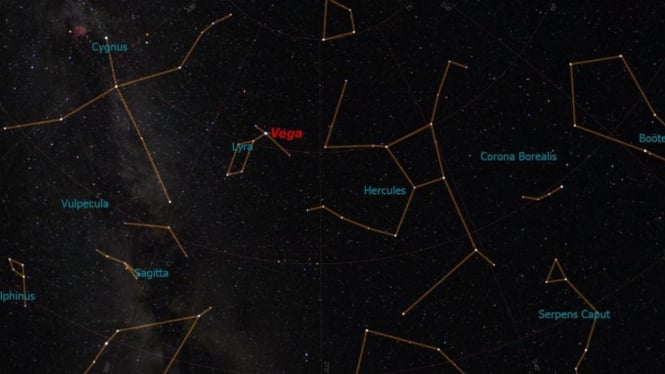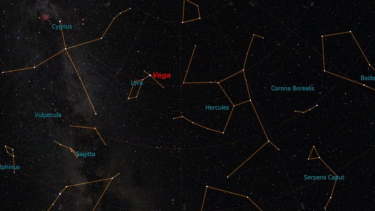- Starry Night Software
VIVA – Vega is a bright star located just 25 light-years from Earth, visible in the summer sky of the Nothern Hemisphere. The star is part of the constellation Lyra and, with the stars Deneb and Altair, forms an asterism known as the Summer Triangle.
The star is only about 450 million years old, which makes it a youngster compared to our solar system (which is 4.6 billion years old). Studies of Vega help astronomers learn more about solar systems that are in the early stages of their formation.
Because the Earth's axis wobbles, our perception of the north gradually shifts to different stars over a 26,000-year cycle. Vega was the North Star several thousand years ago, and it will regain that status in about 12,000 years.
Vega is almost directly overhead in the mid-northern latitudes on a midsummer night. Vega sinks below the horizon for only 7 hours a day and can be seen every night of the year.
Farther south, Vega lies below the horizon for longer periods, but in Alaska, northern Canada, and most of Europe, Vega never sets.
Because Vega's blue-white light is so bright -the star has an apparent magnitude of 0.03- it featured prominently in ancient cultures, from China to Polynesia to Hinduism. The name Vega comes from the Arabic word 'waqi' which means falling or swooping.
"This is a reference to the time when people regarded the constellation Lyra as a swooping vulture rather than a lyre," wrote Michael Anissimov on the website Wisegeek.
Ilustrasi/Langit mendung di atas Kota Jakarta.
- ANTARA FOTO/Rosa Panggabean
The name of Vega and those of other astronomical targets honor the traditional importance of astronomy in Islam, noted one researcher. Following the stars allowed believers to mark the times of prayer and festivals, as well as to find the holy city of Mecca.
Thus, Vega's blue-white light is so bright – the star has an apparent magnitude of 0.03 – it was prominent in ancient cultures, from China to Polynesia to Hinduism. The name Vega comes from the Arabic word 'waqi' which means to fall or swoop down.
"It refers to a time when people thought of the constellation Lyra as a swooping vulture rather than a lyre," wrote Michael Anissimov on the Wisegeek website.
Vega is named in honor of the importance of traditional astronomy in Islam, says one researcher. Following the stars allowed believers to mark prayer times and holidays, as well as locate the holy city of Mecca.
Ilustrasi/Aktivitas ibadah umrah di Tanah Suci Mekah.
- ANTARA/ Prasetyo Utomo
"Thus, hundreds of stars and constellations have Arabic names, such as Altair, Deneb, Vega, and Rigel," wrote Nidhal Guessoum, an astrophysicist at the American University of Sharjah in the United Arab Emirates, in a 2013 article published in the journal Nature.
In modern times, Vega was the first star to be photographed other than the Sun. Astronomers captured the image through the daguerreotype process at Harvard College Observatory, using a 15-inch (38-centimeter) refractor, on July 16-17, 1850.
The star was also chosen for the first spectrographic image in 1872. Amateur astronomer Henry Draper was the first to break down Vega's light to reveal the various elements that make up the star.
Vega rose to prominence in popular culture in the late 1990s after Carl Sagan's novel 'Contact' (1985, Simon & Schuster) was adapted into a Hollywood movie. Starring Jodie Foster, the movie follows an astronomer working in the search for extraterrestrial intelligence (SETI), discovering a signal that appears to be coming from Vega.
Telescopic observations in 2006 revealed that Vega rotates so fast that its poles are several thousand degrees warmer than its equator. The star, which rotates every 12.5 hours, is at 90 percent of its critical rotational speed, or the speed at which objects will tear themselves apart.
In early 2013, astronomers announced that they had discovered an asteroid belt surrounding Vega, suggesting the possibility of a planet amidst the rocks.
The layout shows that there are two regions: an outer region with icy asteroids and a region closer to the star, where warmer space rocks are located.


































